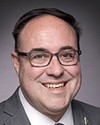Thank you, Mr. Chair.
On behalf of Transport Canada, I would like to thank you for the opportunity to be a witness this evening.
My name is Vincent Robitaille, and I'm the assistant deputy minister responsible for high frequency rail, or HFR, at Transport Canada.
I would like to begin by acknowledging that we're gathered today on the traditional territory of the Algonquin Anishinaabe peoples.
The HFR project is the largest transportation infrastructure project that Canada has seen in generations. The objective of HFR is to offer faster, more reliable and more frequent rail service.
HFR is more than a rail project. Fifteen million people currently live in the Corridor. The populations and the economies of Ontario and Quebec will only continue to increase, as will the demand for all modes of transportation, including passenger rail. This project presents an opportunity to meet future demands while transforming rail travel to a more sustainable and more accessible way of travelling for future generations.
At this moment, VIA Rail cannot make improvements for passenger services. Rail congestion on the current tracks limits the frequency of departures, the reliability of arrivals and the speed of reaching the destination. To put it simply, without a transformative investment, 10 million trips per year would be taken using higher emitting modes.
HFR consists of building a new intercity passenger rail system over 1,000 kilometres in length to serve Toronto, Peterborough, Ottawa, Montreal, Laval, Trois-Rivières and Quebec City.
HFR will provide fast, reliable and frequent service. It will triple the number of rail passenger trips in the corridor to at least 17 million by 2059. It will at least double the number of train departures between major cities, with at least 12 departures per day. It will dramatically improve reliability to ensure that trains leave and arrive on time. It will provide faster service, offering shorter journey times. It will continue to serve communities currently served by Via Rail, such as Kingston, Cornwall and Drummondville, with expected improvements to scheduling and convenience. It will create thousands of well-paying jobs during the design, construction and operation of the service.
As an electrified service, it will deliver significant reductions in GHG emissions. It will positively contribute to the Government of Canada's commitment to reconciliation with indigenous peoples.
The HFR project will be delivered in four phases.
The first phase of the project, from 2017 to 2121, was focused on due diligence of the initial VIA Rail proposal. This assessment concluded that investment in passenger rail was necessary and would bring important social, economic and environmental value.
The government announced in Budget 2022 its decision to proceed with phase 2 of the project—the procurement phase. Also in 2022, a new subsidiary of VIA Rail, VIA HFR – VIA TGF Inc., was created to serve as the project delivery office for HFR.
While the HFR is building capacity, the government needs an innovative procurement process that takes into account the lessons learned from other Canadian and international infrastructure projects. Via HFR serves as technical and commercial adviser during this phase.
Once the procurement is completed and subject to government decisions, the project will then move to phase three, co-development. The co-development phase will be fully led by HFR Inc. The activities will focus on developing and finalizing the HFR design, accelerating engagement with stakeholders and preparing the final project agreement contract. This will be followed by a fourth phase, the actual construction of the project, and the fifth phase, which will be maintenance and operations over 40 years.
The HFR project continues to gather momentum during the procurement phase. In February 2023, the Government of Canada launched a request for qualifications to qualify three consortia to advance to the next phase. In July, the government qualified three bidding teams—composed of many of the most accomplished Canadian and international firms—and invited them to the request for proposals. Just this October, the government launched that request for proposals, which is a critical step that will lead to the selection of a private developer partner for the project. Proposals are scheduled to be received in the summer of 2024, with the evaluation completed in late 2024.
To maximize benefits and innovation, the request for proposals requires bidders to develop two solutions that meet the project outcomes—one with speeds of up to 200 kilometres per hour, and one that includes high-speed segments to achieve shorter journey times. This will allow for a rigorous assessment of the costs and benefits of incorporating high-speed rail on each segment of the corridor.
With this approach, the government will be able to choose the best solution for the HFR based on robust competition between many of the most accomplished Canadian and international firms. We are convinced that this type of competition will maximize innovation and deliver the best project for Canadians.
This concludes my remarks.
Once again, thank you for inviting me to speak on this exciting project.
It will be a pleasure to answer your questions.




